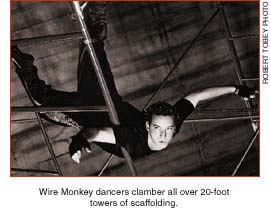
|
|||||
|
|
Learning to Fly: by Amy Kroin
|
||||
|
One man's junk is another guy's
treasure. Just ask Saliq Francis Savage. A couple of years ago Savage
was zipping along on his motorcycle with girlfriend Jennifer Polins
when he spotted some steel scaffolding on display at a neighborhood
yard sale. Though he was not a tag sale habitué -- and was hardly
a collector of steel scaffolding -- something made him stop.
"I went out of town the next day but I couldn't stop thinking about the scaffolding," said Savage. "I called the gentleman who owned it and when I came back I was the proud owner of a bunch of scaffolding." That summer, Savage set up the scaffolding in the garden of his South Hadley home, where it served as a makeshift jungle gym for guests. As Savage watched friends climb all over the structure, the concept for Wire Monkey Dance was born. Wire Monkey, the two-year-old Valley dance ensemble Savage founded with Polins, performs acrobatic and intimate work on intricate sets of scaffolding that move along with the dancers. In a piece performed as part of the Crank It Out! series at Thornes Market in Northampton last fall, the scaffolding was positioned on wheeled carts that sat side by side; in longer pieces, dancers clamber all over multi-leveled 20-foot towers of scaffolding, swinging from bars, climbing up ladders and sliding down wooden planks. For Savage, the troupe's artistic director and set designer, the scaffolding affords possibilities that the standard wooden floor can't provide. "All of the energies that are created when you're dancing on a flat floor have to come from within," he said. "In my training I've found a lot of pleasure in finding that harmony point with the environment. It's like when you're wind-surfing -- you're working off the surface of the waves and turning those shapes into movement. But a flat floor is just an empty canvas. "Seeing that scaffolding -- it was just so three-dimensional. And it lets you use your arms in a way that a floor doesn't. ... In our lifetime we don't spend much time bearing weight on our arms. Babies do it, but then we get up and we sit and we walk. With scaffolding you're bearing weight on your arms, like in capoiera, the Brazilian martial dance where there's so much upper body use, where you're really holding on to things. Before we got upright as a species we had to rely on our arms. Scaffolding lets your whole body move." For two weekends at the Northampton Center for the Arts, the seven members of the Wire Monkey troupe will swing through the air, tug on mammoth rubber bands and perform various feats of strength in Endangered Species, a piece exploring concerns about alienation, survival and the dominance of technology. Produced by the Massachusetts International Festival of the Arts, Endangered Species will feature original music from cellist Stephen Katz and video projections from Peter Avril and Raphael Brand. It's safe to say that dancers who harbor a fear of heights will never find a place in the Wire Monkey ensemble. The sheer athleticism of the work places Wire Monkey in the tradition of companies like Pilobolus, the daring Connecticut-based ensemble that has achieved international acclaim for its sensual and acrobatic choreography. Wire Monkey has a long way to go before its members can rub shoulders with the folks in Pilobolus. And Savage himself acknowledges that the work is not yet "mature." But he and Polins have the ambition to keep things going for the long haul. The troupe's co-choreographer and administrative director, Polins has the kind of resume that you'd expect from someone making a career in the dance world. A Pilates instructor who teaches ballet at the Pioneer Valley Performing Arts High School, she has performed with the Joffery II Dancers, the Milwaukee Ballet and the Zurich Operahouse Ballet and had her work shown in Switzerland, France, Germany, Boston and New York. Savage, on the other hand, characterizes himself as more of a lifelong "mover" than a dancer. "I came to know the world through movement," he said. "I remember walking to school and putting one foot in front of the other and keeping the sight-line the whole time, seeing perspective from a great distance." A childhood tree-climber who then went on to ski, wind-surf and play soccer in high school, Savage had gone sedentary by the time he was a half-hearted math major at Marquette University in Milwaukee. "To understand real analysis, the foundation of calculus, you have to kind of go at it for a while. And right at that point when I had a choice of going at that or not I chose to fill out my last few credits by taking a ballet class." Soon enough, Savage was hooked. After graduation he moved to a "house full of anarchists" in Seattle, where a housemate taking a dance class at the University of Washington inspired him to continue his own study of dance. "It was at the University of Washington where I really dropped into dance," said Savage. "I performed in Doris Humphreys' Shakers, a really spiritual piece where you don't need a lot of technique; you just throw yourself into it." Savage later studied Laban movement analysis, a system for describing and notating all forms of movement that was developed by students of choreographer Rudolph Laban. Savage's study of Laban -- as well as his work these days as a teacher at the School for Body-Mind Centering in Amherst -- have had a profound influence on his development as a dancer and choreographer. "Body-mind centering is a healing art," said Savage. "You look at all the body systems, starting with the skeleton. You palpate each bone, find out how to bend bone, and go right on through to the organs, from the mouth through the digestive tract to the heart, the lungs and so on. You go through each tissue and give it some focused attention and find out what its conflicts are. "Body-mind centering and the Laban work support one another very much. ... With Laban work you find out where your limitations are while with BMC you accept those limitations; your weaknesses are your strengths." The study of Laban and BMC have given Savage's choreography a very deliberate quality. There's a heightened focus on each gesture, each part of the body. The freewheeling aesthetic of contact improvisation -- a highly interactive form of dance that has a sizable following in the Valley -- has also influenced Savage. "Contact is about responding in the moment to the movement being presented to you," said Savage. "... But I have a particular style that is different from what is generally out there and that comes a lot from my studies of body-mind centering. With BMC, you see how all the different tissues in the body have a different quality of mindfulness, and if you can tap into that, those different tissues can start to have dialogues as you dance." The subtleties of these kinds of organ-ligament dialogues might not be apparent to most audience members. But what resonates, in the end, is the determination of this troupe. It's clear that Wire Monkey is looking to break the mold. It's a testament to the vision of Savage and Polins that Wire Monkey has achieved success so early on. In addition to performing as part of the MIFA fall season -- a coup in itself, since MIFA generally showcases work by internationally acclaimed artists -- Wire Monkey will take Endangered Species on the road later this month, where the troupe will appear at the Boston Center for the Arts. The ensemble, which performed in the trees outside the Southwest dorms at UMass earlier this month, is presenting eight performances in total this fall. That's not enough, says Savage. "With just the expense of renting space, paying dancers and having workers' comp, eight performances is not enough," he said. "It doesn't make sense as an investment." After the fall tour is complete, Wire Monkey will produce a video of its work and start applying for grants -- all in the hopes of launching a 25-performance tour of the Northeast down the road. "In the Valley most people make dances that they show just once and then they move on. I think they're content to just make this sort of self-fulfilling art. It fulfills them as artists to do that. I don't want to make that kind of work. I want to make art that's enduring," Savage said. "Whatever that is."
Wire Monkey will present Endangered Species on Sept. 28-29 and Oct. 5-6 at the Northampton Center for the Arts at 8 p.m. For tickets call 536-8059, ext. 3. |
|||||

